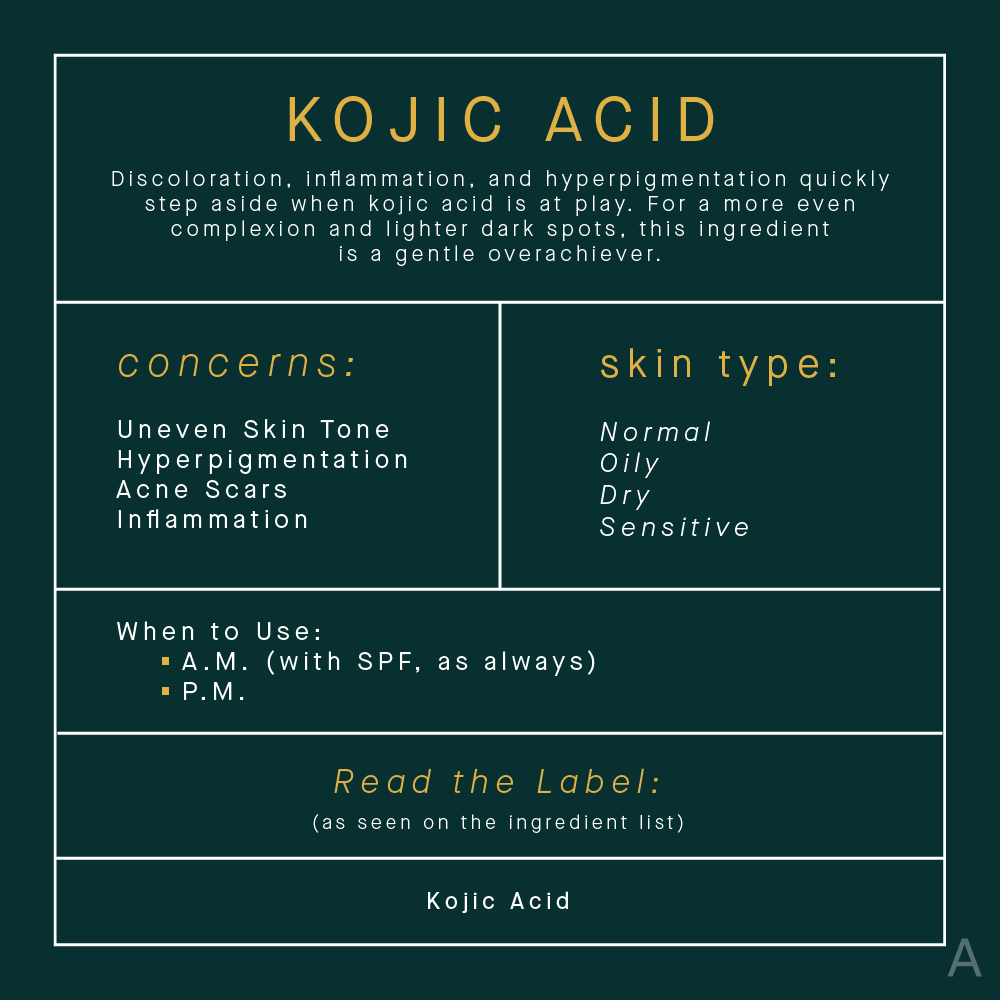 Tretinoin
TretinoinRead the Label: All Of Your Kojic Acid Questions Answered
This gentle skin tone perfector can show results in two short weeks. Here’s what you need to know about this brightening beauty.
Feel like you need a dictionary every time you look at the ingredient list of a beauty product? Still unsure of the difference between retinol and retinoids? What about the unique benefits of vitamins B, C, and E? Are alpha and beta hydroxy acids the same thing? The skincare aisle can be overwhelming, but you don’t need a PhD in cosmetic chemistry to navigate it. With expert help, The AEDITION is demystifying and simplifying the beauty industry — one label at a time.
Stop us if you’ve heard this before: This ingredient is gentle yet can show results in two short weeks! The claim would be a pipedream for most skincare ingredients, but, when it comes to kojic acid, it might be time to believe the hype. Derived from fungi but also a byproduct of select fermented products, kojic acid helps treat hyperpigmentation, melasma, and dark spots and minimizes the appearance of sun damage. While most brightening ingredients come in exfoliant form, kojic acid plays by different rules. Intrigued? Here’s what the experts have to say.
What Is Kojic Acid?
Kojic acid “is naturally found in a variety of fungi as well as through the fermentation of soy and rice,” explains Alison Adams-Woodford, a licensed aesthetician and senior manager of research and development at PCA Skin. Before you get spooked by the prospect of putting fungus on your face, Adams-Woodford notes exactly how it benefits the skin. “It is used in cosmetics primarily due to its ability to inhibit tyrosinase, an enzyme critical to the formation of hyperpigmentation that causes skin discoloration,” she shares.
Thanks to its ability to act on processes that lead to unwanted pigmentation, kojic acid has come to be seen by many as a less controversial alternative to hydroquinone, which was quietly banned from use in skincare in late 2020 as part of the CARES Act.
The Benefits of Kojic Acid in Skincare
We’ve already touched on a few of the benefits of kojic acid – brightening, treating hyperpigmentation – but that’s just the beginning. Allow us to break it down. Apart from mitigating the discoloring effects of melasma, light damage (ultraviolet and visible), and inflammation, kojic acid also has antimicrobial properties, says Janna Ronnert, aesthetician and founder of IMAGE Skincare. This makes it beneficial for those experiencing active acne breakouts and those looking to minimize the appearance of post-inflammatory hyperpigmentation (PIH) caused by pimples and lingering acne scars.

For those curious about its lightening properties, the ingredient is not a bleaching agent. “By blocking tyrosine from forming, it then prevents melanin production,” explains Amy Spizuoco, DO, a board certified dermatologist and founder of True Dermatology in New York City. “Decreased melanin production may have a lightening effect on the skin.” So, if you have spot-specific concerns or are looking to correct specific areas of hyperpigmentation, keep reading.
The Best Candidates for Kojic Acid
Those looking for a more even complexion need not worry, this ingredient is safe for all skin tones and skin types given its slow and steady approach. As Ronnert explains, it “is especially well-suited for those who suffer from pigmentation concerns like sun damage or age spots.” Since hyperpigmentation does not live only on the face, kojic acid may also be worth incorporating into your body care routine.
Since uneven skin tone is one of the most common (and lamented) visible signs of aging, the evening properties of kojic acid make it a youth-preserving favorite. “It has been said that pigmentation is the new wrinkle, so providing lightening and brightening benefits to the skin will lead to age-later results,” Ronnert adds.
How to Find the Right Kojic Acid Product
Due to its gentleness and multitude of benefits, kojic acid is a favorite of product formulators. It can be found in everything from at-home skincare and professional chemical peels to prescribed medications, soaps, and powders. If you are looking to treat cases of sun spots or hyperpigmentation, consult with a professional first to discuss what format makes the most sense for your concern. “Skin discoloration can occur on larger areas of the body like arms and legs and those areas are more easily treated with a bar than a serum,” Adams-Woodford notes.
As with any formulation, the ingredients kojic acid is paired with matter. “[They] need to be stable at a similar pH,” Adams-Woodford cautions. “It is also good to pair kojic acid with other ingredients that address skin discoloration through different mechanisms to disrupt the biological pathway of melanin production from multiple angles.” Her picks? Azelaic acid, licorice, retinoids, arbutin, and lactic acid (to name a few). “Additionally, calming ingredients are a good addition to kojic acid-containing products as inflammation can worsen skin discoloration,” she notes.
Those looking to treat specific spots can find solace in the PCA Skin Pigment Gel HQ Free. Use it after cleansing but before sunscreen in the morning or as a moisturizer in the evening. Also on the serum front, the SkinCeuticals Discoloration Defense pairs kojic acid with tranexamic acid and niacinamide to reduce stubborn pigment, while the Neutrogena Rapid Tone Repair Dark Spot Corrector features a powerhouse trio of kojic acid, retinol, and vitamin C.
If you prefer a treatment step, the Tracie Martyn Enzyme Exfoliant uses natural exfoliators (like pineapple enzymes and fruit acids) to refine skin texture and kojic acid and volcanic minerals to even skin tone and remove impurities. When it comes to cleansing and toning, look no further than the vitamin C and kojic acid-infused HoliFrog Sunapee Sacred-C Powder Wash and the Versed Weekend Glow Daily Brightening Solution, which pairs alpha hydroxy acids (AHAs) with kojic and azelaic acids to lift dead skin cells, clear pores, and brighten dark spots.
How to Add Kojic Acid to Your Skincare Routine
The beauty of kojic acid is its versatility, so finding a place for it in your routine doesn’t have to be a chore. The best practice when introducing any new skincare product or ingredient is to avoid the urge to rush into it. “It can be used daily and, like any lightening agent, it is best to use at bedtime,” Dr. Spizuoco shares. “If you have sensitive skin, try starting slow, using it two to three times a week for a month and then nightly.”
Kojic acid can cause contact dermatitis, leading to itchiness, redness, and irritation, especially for those who are on the more sensitive side. To avoid this, check that the ingredient is formulated at less than one percent and slowly build up tolerance as Dr. Spizuoco suggests.
As is the case with all (read: no exceptions) ingredients, kojic acid must be used within a routine that includes sunscreen in the morning. “The best way to avoid developing further pigmentation concerns is to be proactive, so I always recommend using a daily moisturizer with sunscreen built-in,” Ronnert shares. We’re fans of the IMAGE Skincare Prevention+ Daily Hydrating Moisturizer SPF 30+.
The Takeaway
Kojic acid is a great skincare addition for those experiencing unwanted pigmentation and dullness. As though that wasn’t enough, it also offers antimicrobial benefits that may be beneficial for those prone to acne while brightening the complexion. Safe for most all skin types, a good SPF will help to prevent future damage while kojic acid treats existing issues.
All products featured are independently selected by our editors, however, AEDIT may receive a commission on items purchased through our links.
More Related Articles
Related Procedures

AI Plastic Surgeon™
powered by'Try on' aesthetic procedures and instantly visualize possible results with The AI Plastic Surgeon, our patented 3D aesthetic simulator.


